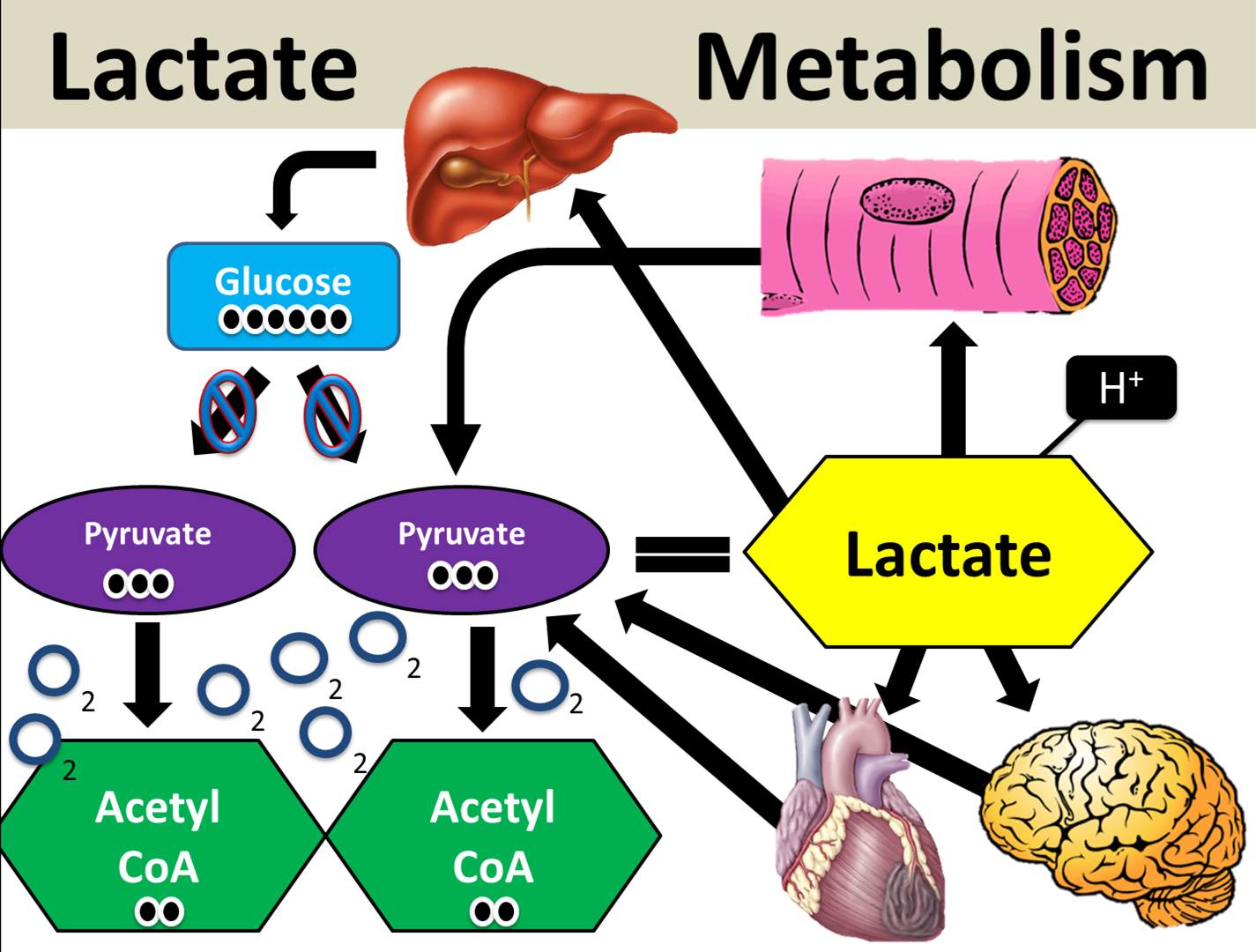Stop blaming lactate for your lack of endurance
The short story of Lactate, the most misunderstood molecules/hormones/signaling mechanisms/intermediates of all time
By Dr. Andy Galpin, Ph.D., Professor at the Center for Sport Performance at California State University, Fullerton, Director of the Biochemistry and Molecular Exercise Physiology Laboratory, and Member of Team 3FU3L
Lactate is formed as a byproduct of anaerobic metabolism, or more specifically, the breakdown of sugar (glucose or glycogen). Glucose is a 6-Carbon molecule (see the 6 black circles in the accompanying diagram) that is split into 2 Pyruvates (each Pyruvate being a 3C molecule). The breakdown process that converts sugar into Pyruvate costs a bit of energy in the form of 2 ATP (the only molecule animals can use to produce cellular energy), but yields a few more ATP (4) and produces a few NADH+. The result is a net positive of 2 ATP (make 4, cost 2, net = 2).
What you’ll notice, unfortunately, is that we’ve burned an entire molecule of glucose and only generated 2 ATP. It’s not nearly enough energy to power something like exercise. That’s our first clue that the point of glycolysis (splitting sugar to make pyruvate) is not to make ATP, but to do something else.
If we have Oxygen (02) available, we will transport these molecules to the mitochondria and break the Pyruvates into Acetyl Coeznyme A (a 2-Carbon molecule, ACoA). This process is also exothermic, so a small amount of ATP is generated.
More importantly, you’ve converted 2 3-Carbon molecules (Pyruvate) into 2 2-Carbon molecules (ACoA). These means you started with 6 Carbons and now have molecules of ACoA that account for 4 Carbons (i.e. you’ve “lost” 2 Carbons). It turns out these two “lost” Carbons are bonded with the O2 (forming CO2 – Carbon DiOxide); this CO2 is exhaled as waste.
The ACoA created by the interaction of the Oxygen with the Pyruvate will produce a turn of the Tricarboxylic Acid (TCA) Cycle (aka “Kreb’s Cycle”, aka “Citric Acid Cycle”). Each turn yields the same results previously discussed: 2 more CO2 (from the Pyruvate to ACoA), a few ATP (from both the glucose breakdown and the ACoA creation), and a bunch of “high energy intermediates (HEI)” (NADH+, FADH2, etc.). These HEI are sent to another process called the “Electron Transport Chain” (aka Proton Pump), which generates a boat load of ATP.
Therefore, in total, If you have O2 and can convert your 2 Pyruvates into ACoA, you go from 6 Carbons to ZERO (which is what actually makes you lose weight BTW…more on this later), and you generate >30 ATP!!!!
Unfortunately, that is all predicated on having O2 – meaning AEROBIC.
Pyruvate (P) will not give up its Carbon (C) unless it knows a receptor is available (i.e. O2) because free C essentially makes the environment (aka you) too acidic. So what to do? Find a way to deal with P when O2 is not around. Enter our dear friend: Lactate.
In human skeletal muscle, lactate is effectively only a P that has accepted a Hydrogen ion (aka “proton”). This is significant as H+ is acid (think “pH scale”). So by converting P into Lactate, you actually REDUCE the amount of acid in the environment. This is why some folks call lactate an acid “buffer”. Your body knows this, which is why it increases its ventilation (transporting O2 in and CO2 out) post anaerobic exercise. You breathe in O2, the O2 accepts the H+ that is bound to P in what was called “lactate,” and water and Pyruvate are formed. The P generated is then converted to ACoA, and you’re on your merry way. So benefit one of lactate is: to buffer acidity.
The second benefit of lactate is that it can be set into the blood and shipped to places like the heart, liver, brain, and non-exercising skeletal muscle fibers (both within the same muscle being used or to an entirely separate muscle). And since La is simply a P holding onto an H+, these tissues that La is transferred into can bring in O2, and create water and some free ACoA. The liver, in particular, can combine 2 La molecules and form a brand new glucose molecule. This process of converting La to Glucose is called gluconeogenesis.
Even more than these benefits, YOUR BODY OFTEN PREFERS LACTATE AS A FUEL SOURCE, even over Glucose. Remember, I have to burn a few ATP to metabolize glucose (the net 2 ATP from glycolsis), but I don’t burn ANYTHING to get ATP from Lactate,making it more energetically favorable.
Other recent work also suggests the brain may be particularly happy to use lactate. Remember, lactate is being generated anywhere you are going through anaerobic glycolysis (i.e. your muscle when exercising, but also your red blood cells, your brain, etc.). Why do we know people who exercise (particularly hard), are generally happier, have better memory, etc. etc.? Well, part of that answer is because your brain is primarily anaerobic, mostly using glucose as a fuel. HOWEVER, some research suggests it PICKS LACTATE OVER GLUCOSE, if given the option. Thus, it’s plausible the La you generate from your workout literally fuels your brain, helping to improve its function. You could even argue that this is not a secondary benefit – but actually the true purpose of exercise, to provide the brain with its preferred fuel source.
Happy interval training!



